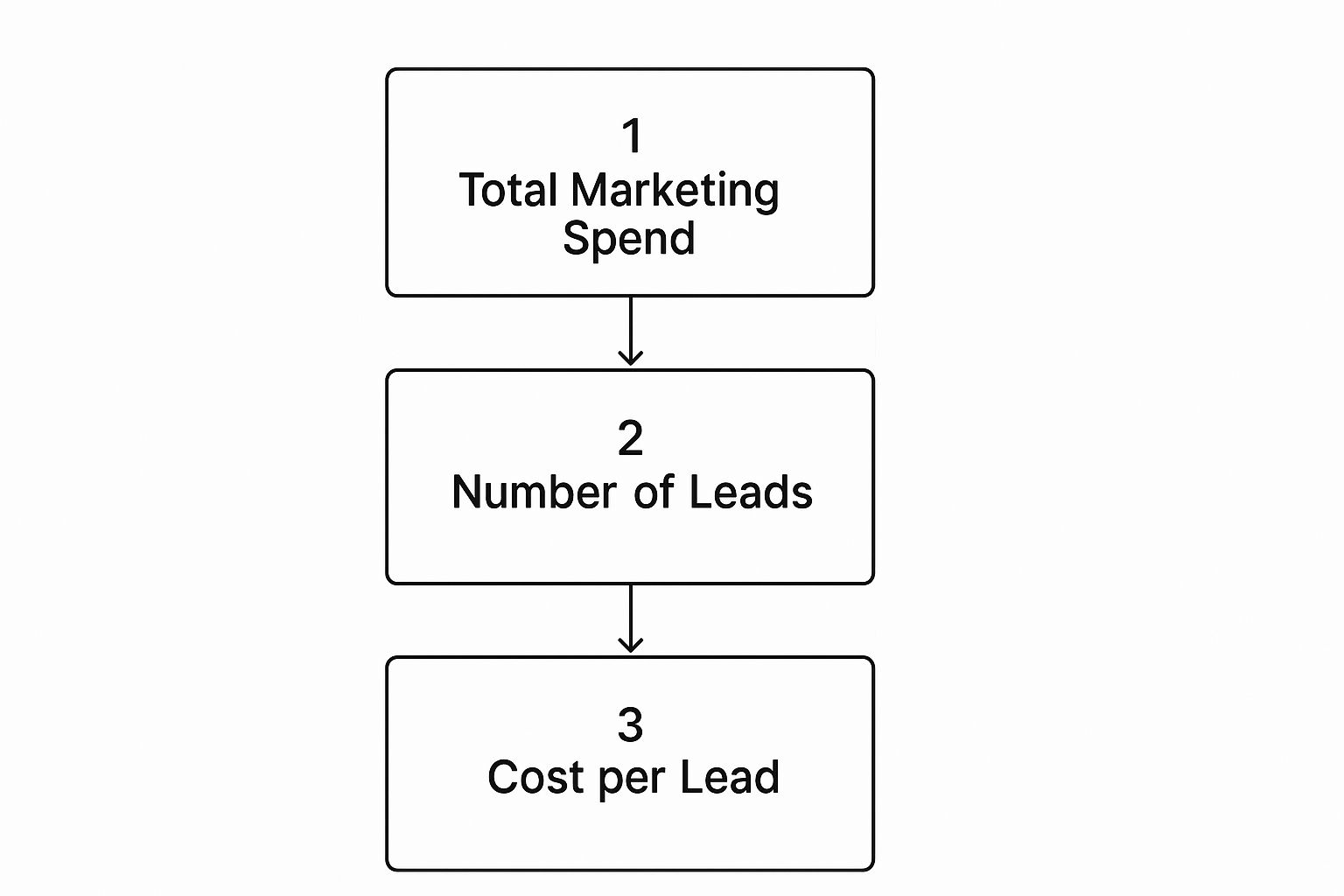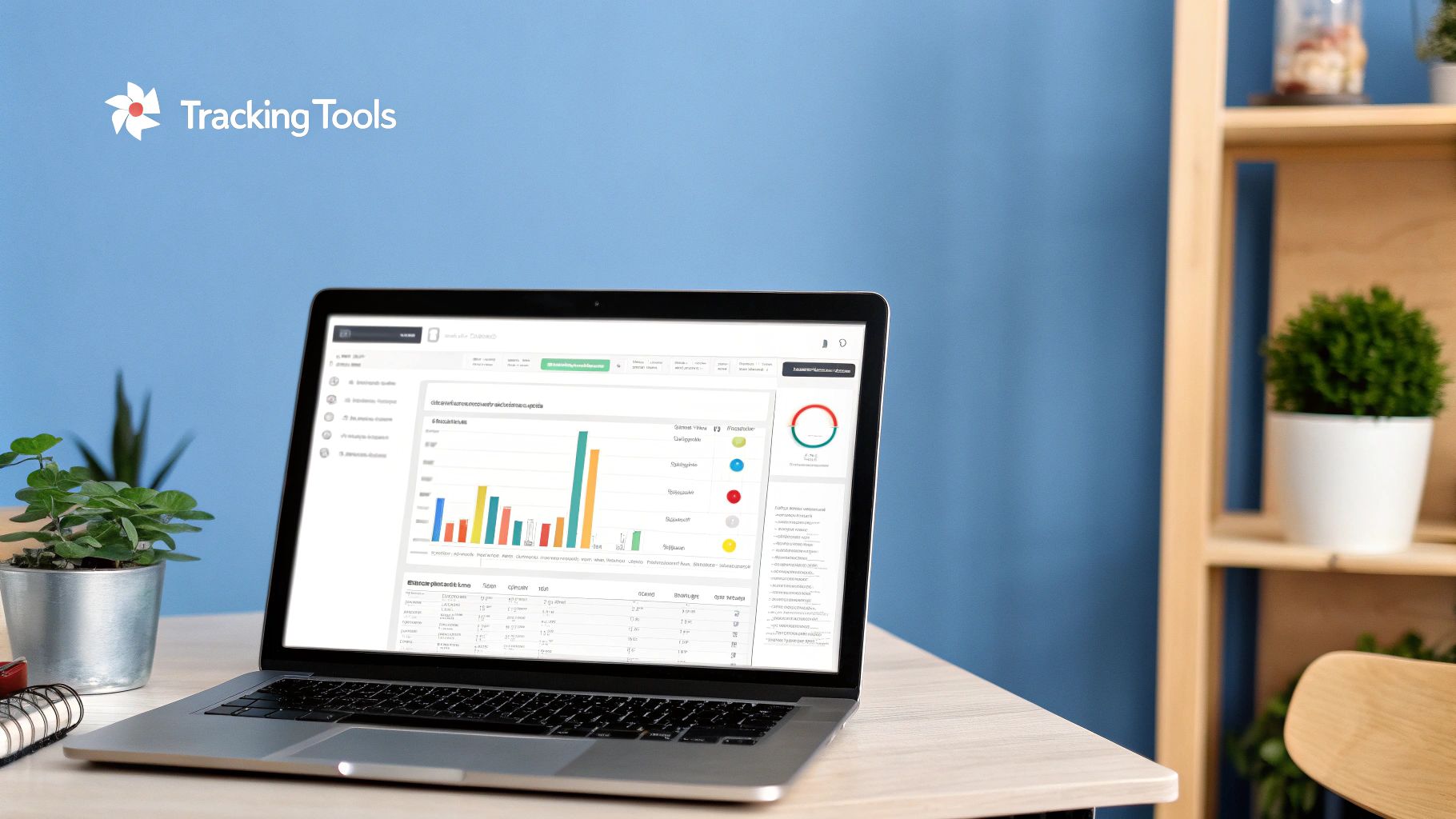Master Your Cost Per Lead Calculation

Cost Per Lead Calculation: Cost Per Lead, or CPL, is a straightforward but powerful metric. It tells you exactly how much you spend to get each new business lead. At its core, the cost per lead calculation is simple: Total Campaign Cost ÷ Total Number of Leads Generated. Getting a firm grip on this number is the first real step toward a smarter, more efficient marketing strategy.
Why Your Business Must Master CPL
It’s a common mistake to see CPL as just another number on a spreadsheet. In reality, it’s the financial compass for your entire marketing operation. It shifts your decisions from pure guesswork to data-backed strategy, giving you the power to justify spend, trim the fat, and ultimately drive sustainable growth. When you truly understand your CPL, you can allocate your budget with surgical precision.
This metric is especially vital for UK businesses trying to navigate recent economic shifts. Think about it: the inflationary pressures we’ve all felt have quietly driven up marketing costs. Between 2021 and 2024, UK consumer prices shot up by 20.8%. For many businesses, this meant their CPL increased even if their lead numbers stayed flat. This just goes to show why you need to constantly revisit your cost per lead calculation to make sure your marketing pounds are still working effectively. You can read more about how these UK economic trends are impacting businesses in the Parliament’s research briefings.
From Vague Spend to Strategic Investment
Imagine a UK tech startup putting £5,000 a month into their marketing. They’re running some Google Ads and dabbling in content marketing. Without a clear CPL, all they see is a single pool of leads, leaving them clueless about which channel is actually pulling its weight.
But once they apply the simple CPL formula, the picture becomes much clearer:
- Google Ads: They spent £4,000 and generated 80 leads. That’s a CPL of £50.
- Content Marketing: They spent £1,000 and generated 50 leads. That’s a CPL of £20.
Suddenly, the path forward is illuminated. Their content marketing is dramatically more cost-effective. Armed with this insight, they can make an informed decision to shift some of their Google Ads budget over to their high-performing content strategy. This move could lower their overall CPL without them having to spend a single extra penny on marketing.
This granular view is where the true strategic value of CPL lies. It’s not about finding a single ‘magic number’ but about understanding the relative performance of each marketing activity you invest in.
This is the kind of analysis that transforms marketing from a cost centre into a strategic growth driver. For a deeper dive into how this metric works, check out our guide on understanding CPL as a key metric for marketing efficiency. It really is the difference between blindly throwing money at advertising and making every pound work as hard as possible to grow your business.
Accurately Tracking Your Campaign Costs
A solid cost per lead calculation hinges on one simple truth: you have to account for every single penny. It sounds obvious, but you’d be surprised how many people just glance at their ad spend and call it a day. It’s an easy trap to fall into, but it gives you a dangerously misleading sense of success with an artificially low CPL.
To get a real measure of your marketing investment, you’ve got to look beyond the big, flashy numbers in your Google Ads dashboard. The true cost of any campaign is a mix of both direct and indirect expenses, and you need to get a handle on both for your numbers to mean anything.
Cost Per Lead Calculation: Differentiating Direct and Indirect Costs
Think of direct costs as anything with a clear invoice attached. These are the payments you make to external partners to get your campaign off the ground and are usually the easiest to track.
Direct Costs include:
- Ad Spend: The money you’re paying directly to platforms like Google, Facebook, or LinkedIn.
- Agency Fees: The retainer you pay to a specialist PPC agency like us to manage your campaigns.
- Software Subscriptions: Costs for tools you can’t live without, like landing page builders, CRMs, or specific analytics software.
Indirect costs are where things get a bit murkier. These are your internal expenses, often shared across multiple projects, which makes them tougher to pin down to a single campaign. But ignoring them means you’re not factoring in some of your most valuable resources.
Indirect Costs include:
- Team Salaries: A portion of the salaries for any in-house team members who touch the campaign.
- Content Creation: The time and effort that goes into writing blog posts, shooting videos, or crafting ad copy.
- Design Work: The cost associated with creating all those graphics, banners, and landing page layouts.
The goal isn’t to track every minute of every day, but to make a reasonable estimate of the internal resources dedicated to a campaign. This is crucial for understanding the true total cost of your lead generation efforts.
Setting Up a Simple Tracking System
You don’t need complicated or expensive software to get this right. Honestly, a well-organised spreadsheet is often all you need to capture your campaign costs accurately. The key is to create a simple template you can reuse for every new campaign you launch.
Here’s a quick and practical example of how you could structure it:
| Cost Category | Item | Estimated Cost (£) |
|---|---|---|
| Direct Costs | Google Ads Spend | £1,500 |
| Agency Management Fee | £500 | |
| Landing Page Software (Unbounce) | £75 | |
| Indirect Costs | Marketing Manager’s Time (10%) | £400 |
| In-house Designer’s Time (5 hours) | £125 | |
| Total Campaign Cost | £2,600 |
In this scenario, if you only tracked your ad spend, you’d think your campaign cost was £1,500. But the real, all-in figure is actually £2,600.
Using that lower number would completely skew your CPL, potentially tricking you into pouring more money into a campaign that’s actually unprofitable. By meticulously tracking both direct and indirect costs, you give yourself the accurate data needed to make genuinely smart decisions.
Of course. Here is the rewritten section, crafted to sound like it was written by an experienced human marketing expert.
Putting CPL to the Test: A Multi-Channel Campaign Breakdown
Theory is great, but let’s get our hands dirty. The best way to really understand the cost per lead calculation is to see it in action with real-world numbers. So, let’s walk through a practical example.
Imagine a UK-based e-commerce brand running a big one-month promotion. They’re not putting all their eggs in one basket; they’re spreading their budget across three different channels to see what sticks. This is the kind of scenario where CPL really starts to show its value.
Tallying Up the Costs and Leads
First things first, we need to know how much was spent. It’s not just about the ad budget; for an accurate picture, you have to include all the associated costs.
- Google Ads: They pushed £1,500 into a targeted search campaign.
- Facebook Ads: Another £800 was spent on a campaign aimed at a very specific customer demographic.
- Influencer Collaboration: They teamed up with a micro-influencer, paying a one-off fee of £300 for a few promotional posts.
Next, we look at what they got back. For this campaign, a ‘lead’ is anyone who signed up for the promotional discount through a special landing page.
- Google Ads delivered 120 leads.
- Facebook Ads chipped in with 95 leads.
- The Influencer Collaboration brought in a respectable 45 leads.
Add it all up, and we have a total campaign spend of £2,600 which generated a total of 260 leads.
This diagram shows you the simple maths behind the CPL formula.
It’s a straightforward flow: total marketing spend divided by the total number of new leads gives you your cost per lead.
Digging Deeper for the Real Insights
Now we can do the top-level calculation: £2,600 ÷ 260 leads = £10 CPL.
A tenner per lead might seem pretty good at a glance. But the real magic happens when you break it down by channel. This is where you find the insights that let you make smarter, more strategic decisions next time around.
Let’s run the numbers for each channel individually:
| Marketing Channel | Total Cost | Leads Generated | Cost Per Lead |
|---|---|---|---|
| Google Ads | £1,500 | 120 | £12.50 |
| Facebook Ads | £800 | 95 | £8.42 |
| Influencer Collab | £300 | 45 | £6.67 |
Now that tells a much more interesting story, doesn’t it?
While Google Ads brought in the highest volume of leads, it was also the priciest channel per lead. On the flip side, the influencer collaboration generated the fewest leads but was by far the most cost-effective, with a CPL of just £6.67.
This is precisely why a channel-specific cost per lead calculation is so powerful. It takes you beyond a simple, blended average and shows you which parts of your marketing machine are actually driving efficient growth.
With this data in hand, the e-commerce brand can plan its next move. They might decide to pull some budget from Google Ads and invest more in their influencer programme. Or perhaps they’ll focus on tweaking the Facebook campaign to see if they can get its CPL even lower. This is what data-driven marketing really looks like.
Benchmarking Your CPL Against Industry Averages
Right, you’ve run the numbers and have your cost per lead calculation staring back at you. But what does that figure actually tell you? A CPL of £25 could be a roaring success for one business and a complete disaster for another. Without context, it’s just a number.
This is where benchmarking comes in. The only real way to know if your campaigns are genuinely performing well is to see how your CPL stacks up against the averages in your specific industry and channel. A ‘good’ CPL isn’t some magic figure plucked from thin air; it’s a moving target that shifts based on your sector, the audience you’re after, and even how much your product or service is worth.
Cost Per Lead Calculation: What Does a ‘Good’ CPL Look Like in the UK?
In the UK market, a whole host of factors can push your CPL up or down. Broader economic trends are a massive influence. For example, data from the Office for National Statistics (ONS) shows that as consumer prices and inflation fluctuate, marketing costs often follow suit, especially in competitive sectors like finance, tech, and real estate.
Take the UK financial services industry. We’ve seen average CPLs swing wildly from around £30 to over £80. That huge gap comes down to how fierce the competition is, how sophisticated the campaign is, and the specific product being promoted.
The key thing to remember is that your CPL doesn’t exist in a vacuum. It’s directly tied to how competitive your industry is and the wider economy, which makes regular benchmarking an absolute must for setting realistic targets.
Example UK CPL Benchmarks by Industry
To give you a better feel for things, it’s helpful to look at some typical CPL ranges across different UK industries. These aren’t set in stone, but they offer a solid starting point for seeing where you might fit in.
| Industry Sector | Average CPL Range (£) | Key Influencing Factors |
|---|---|---|
| B2B Technology & SaaS | £70 – £200+ | Long sales cycles, high lifetime value, niche targeting |
| E-commerce (Retail) | £15 – £45 | Impulse buys, lower order values, high competition |
| Financial Services | £30 – £80 | High regulation, trust factors, intense competition |
| Healthcare | £50 – £120 | Strict regulations, high-value services, patient trust |
| Real Estate | £40 – £100 | High-value transactions, local competition, market conditions |
As you can see, the numbers vary massively. This is precisely why comparing your CPL to a business in a completely different field is a pointless exercise. You need to zero in on your own industry and, if possible, get even more granular by looking at your direct competitors.
Of course, CPL is just one piece of the puzzle. The ultimate goal is always profitability, which means you need a solid grasp of your entire marketing funnel. To see how CPL fits into the bigger picture, check out our guide on how to calculate marketing ROI, which will help you connect your lead costs directly to your bottom line.
Proven Strategies to Lower Your Cost Per Lead
Knowing your cost per lead calculation is one thing, but actively forcing that number down is where the real magic happens. A lower CPL means every marketing pound you spend works harder, directly boosting your bottom line without you having to throw more money at your budget.
So, how do we do it? The key is to systematically plug the leaks in your marketing funnel and double down on what’s already delivering results. This isn’t about making massive, risky changes overnight. It’s about a series of smart, data-led adjustments.
Refine Your Audience Targeting
One of the fastest ways to slash your CPL is brutally simple: stop showing your ads to the wrong people. Every single irrelevant click is just money down the drain. It’s time to get into your Google Ads and social media platforms and be ruthless with your targeting.
- Negative Keywords: Get aggressive with your negative keyword lists. If you’re selling premium leather shoes, you absolutely do not want to pay for clicks from people searching for “cheap,” “repair,” or “second-hand.” Exclude them.
- Audience Exclusions: Are you seeing leads come in from a specific demographic that never converts into a sale? Cut them loose. Focus your budget on the audiences that have already proven their value.
- Lookalike Audiences: Don’t just build lookalikes from all your website visitors. That’s too broad. Instead, build them based on your best customers—the ones who spend the most or have the highest lifetime value. This focuses your spend on prospects who mirror your most valuable clients.
Optimising your spend is a huge piece of the puzzle, especially when a big chunk of your costs comes from platforms like Google Ads. Getting a grip on your budget is non-negotiable. It’s shockingly easy to waste money without realising it, so it’s vital to know about avoiding common pitfalls in Google Ads budget management.
A/B Test Your Landing Pages Relentlessly
Your landing page is the final hurdle. It’s where a curious click becomes a valuable lead. Even tiny improvements here can have an outsized impact on your conversion rate, which in turn, crushes your CPL. Don’t just publish a page and cross your fingers. Test. Everything.
Start with the elements that pack the biggest punch:
- Headline: Pit a benefit-driven headline against one that focuses on features. See which one resonates more.
- Call-to-Action (CTA): Try different button copy. Does “Get My Free Quote” work better than “Start Now”? What about the button colour?
- Page Layout: Test a version with a much shorter form. Maybe try moving your best testimonial right to the top of the page.
Here’s a real-world example: We worked with a local service business whose landing page was converting at a steady 4%. We tested a new headline and simply changed their CTA button from blue to a bright orange. The result? The conversion rate jumped to 7%. Their traffic and ad spend didn’t change, but they nearly doubled their lead volume, effectively cutting their CPL in half.
Improve Your Ad Creative and Relevance
Platforms like Google and Facebook actually reward you for being relevant. A better, more relevant ad often earns a higher Quality Score or relevance score. This translates directly to lower click costs and better ad positions. Basically, you’re making their platform better for users, so they help you out.
Focus on creating a strong “scent trail” from your ad copy all the way to your landing page. If your ad screams “50% Discount on First Orders,” that exact phrase needs to be front and centre on the page they land on. This simple alignment makes for a much better user experience and signals to the ad platform that you’re delivering on your promise.
For a deeper dive into these kinds of tactics, our guide on how to improve Google Ads performance is packed with more specific strategies.
Common Questions About Cost Per Lead Calculation
Even when you’ve got a firm grip on the formula, some practical questions always come up once you start using the cost per lead calculation in your day-to-day marketing. It happens to everyone. Let’s run through a few of the most common ones we hear to clear up any lingering confusion.
Getting these details right is what makes your CPL metric more than just a number—it turns it into a genuinely useful tool for making smarter strategic decisions.
How Often Should I Calculate CPL?
This is a classic “it depends” question. There isn’t a single right answer because the best frequency really hinges on the rhythm of your business and marketing efforts. Most businesses, however, tend to fall into one of two camps.
- Campaign-Based: This approach is perfect for short, intense marketing pushes that have a clear start and end date. Calculating your CPL at the end of a specific promotion gives you a neat, self-contained performance report.
- Monthly Tracking: For your ongoing, “always-on” marketing activities like SEO or continuous social media campaigns, a monthly calculation is absolutely essential. Think of it as a regular pulse check on your overall marketing health.
For most companies, a mix of both works best. Use campaign-based calculations for your specific initiatives and then run a monthly report to see your overall, blended CPL.
What Is the Difference Between CPL and CPA?
This is a frequent point of confusion, but the distinction is critical. The easiest way to think about it is to see them as two different stages of the customer journey.
- Cost Per Lead (CPL): This measures the cost simply to generate interest. It’s the price you pay for someone to metaphorically raise their hand and say, “I’m interested,” by filling out a form, downloading an ebook, or making an enquiry.
- Cost Per Acquisition (CPA): This measures the cost to actually gain a paying customer. CPA tracks how much you spent to convert that initial interest into a genuine sale.
In short, CPL focuses on the top of the funnel (capturing interest), while CPA measures the bottom of the funnel (securing a purchase). Both are vital metrics, but they tell you very different stories about your marketing and sales performance.
Cost Per Lead Calculation: How Can I Track Leads from Offline Activities?
Tracking leads from something like a magazine ad or a trade show stand can feel a bit tricky, but it’s entirely doable with a bit of forward planning. The key is to create a unique, trackable bridge from the offline world to your digital one.
Here are a few practical ways we’ve seen this work brilliantly:
- Unique Promo Codes: Offer a special discount code that’s exclusive to that offline channel. For example, use “TRADESHOW20” only at the event.
- Dedicated Landing Pages: Create a simple, memorable URL (like yoursite.co.uk/offer) that you only promote in your offline materials. Any traffic hitting that page can be directly attributed to that specific activity.
By tying your offline efforts to digital tracking mechanisms, you can easily incorporate their costs and results into your overall cost per lead calculation. If you’re looking for more ways to fill your pipeline, you might find our guide on the best ways to generate leads useful.
At PPC Geeks, we turn complex data into clear, actionable strategies that drive real growth. If you’re ready to move beyond basic metrics and get an expert team to lower your CPL and maximise your ROI, it’s time we had a chat. Get your free, in-depth PPC audit today at https://ppcgeeks.co.uk.
Author
Search Blog
Free PPC Audit
Subscribe to our Newsletter
The Voices of Our Success: Your Words, Our Pride
Don't just take our word for it. With over 100+ five-star reviews, we let our work-and our satisfied clients-speak for us.
"We have been working with PPC Geeks for around 6 months and have found Mark and the team to be very impressive. Having worked with a few companies in this and similar sectors, I rate PPC Geeks as the strongest I have come across. They have taken time to understand our business, our market and competitors and supported us to devise a strategy to generate business. I value the expertise Mark and his team provide and trust them to make the best recommendations for the long-term."
~ Just Go, Alasdair Anderson




